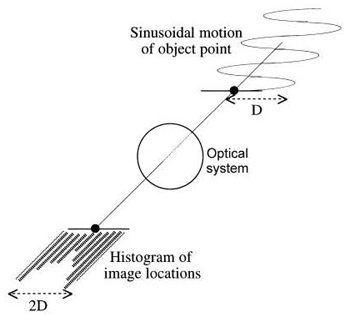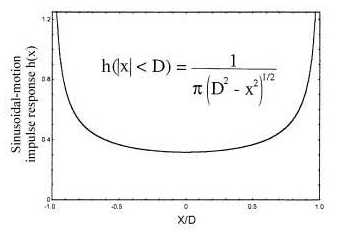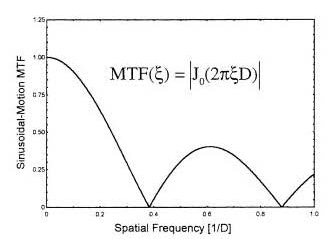Sometimes the platform on which the optical system is mounted vibrates. The effect of the vibration is typically analyzed one frequency at a time, thus assuming sinusoidal motion. The most important distinction is between high-frequency and low-frequency motion, comparing the temporal period of the motion waveform to the exposure time of the sensors τe. The case of high-frequency sinusoidal motion, where many oscillations occur during exposure time τe, is the easiest to analyze. As seen in Fig. 3.2, we assume that any object point undergoes sinusoidal motion of amplitude D with respect to the optic axis. The corresponding image-point motion will build up a histogram impulse response in the image plane. This impulse response will have a minimum at the center of the motion and maxima at the image-plane position corresponding to the edges of the object motion, because the object is statistically most likely to be found near the peaks of the sinusoid where the object motion essentially stops and turns around. The process of stopping and turning leads to more residence time of the object at those locations and thus a higher probability of finding the object near the peaks of the sinusoidal motion.
If the sinusoidal object motion has amplitude D, the total width of h(x) is 2D, assuming unit magnification of the optics. There is zero probability of the image point being found outside of this range, which leads to the impulse response depicted in Fig. 3.3.


If we take the Fourier transform of this h(x), we obtain the corresponding vibration MTF seen in Fig. 3.4.1

For low-frequency sinusoidal vibrations, the image quality depends on whether the oscillation occurs near the origin or near the extreme points of the object movement during the exposure time. As stated earlier, the velocity slows near the extreme points and is at its maximum near the center of the motion. In the case of low-frequency sinusoidal vibrations, a more detailed analysis is required to predict the number of exposures required to get a single lucky shot where there is no more than a prescribed degree of motion blur.2
References
- O. Hadar, I. Dror, N. S. Kopeika, "Image resolution limits resulting from mechanical vibrations—Part IV," Opt. Eng. 33, p. 566 (1994).
- D. Wulich and N. S. Kopeika, "Image resolution limits resulting from mechanical vibrations," Opt. Eng. 26, p. 529 (1987).
G. D. Boreman, Modulation Transfer Function in Optical and Electro-Optical Systems, SPIE Press, Bellingham, WA (2001).
View SPIE terms of use.
